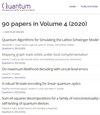具有和不具有社团结构的量子复杂网络中高斯态的传输和路由
IF 5.1
2区 物理与天体物理
Q1 PHYSICS, MULTIDISCIPLINARY
引用次数: 0
摘要
量子态转移的目标是避免需要物理传输量子信息的载体。这是通过使用适当设计的哈密顿量来实现的,该哈密顿量诱导一个子系统的状态转移到另一个子系统。一个鲜为人知的状态转移的推广考虑了多个系统,这样任何对都可以交换量子信息,并且传输可以在任何时间发生,独立地开始和停止。这有时被称为量子态的路由。状态转移尤其受到了广泛的关注,然而绝大多数的状态转移和路由结果都涉及到在受限结构网络中传输的量子比特。这里我们考虑单模高斯态的路由和量子谐振子复杂网络的纠缠。我们比较了传输在单步完成但有效哈密顿量仅近似传输状态的协议与原则上可以完美传输但传输分两步完成的协议,并说明了传输保真度的状态依赖性。我们发现,即使在随机和均匀网络中,对于任何链路密度,传输保真度仍然取决于节点的程度,并且在随机和复杂网络中,社区结构都控制着用于传输的高频正态模式的出现。最后,我们发现足够复杂的网络可能比表面相似的随机网络具有更好的路由性能。我们的研究结果为进一步探索社区结构在国家转移和相关任务中的作用铺平了道路。本文章由计算机程序翻译,如有差异,请以英文原文为准。
Transfer and routing of Gaussian states through quantum complex networks with and without community structure
The goal in quantum state transfer is to avoid the need to physically transport carriers of quantum information. This is achieved by using a suitably engineered Hamiltonian that induces the transfer of the state of one subsystem to another. A less known generalization of state transfer considers multiple systems such that any pair can exchange quantum information and transfers can take place at any time, starting and stopping independently. This is sometimes called routing of quantum states. State transfer in particular has received a great deal of attention, however the vast majority of results in both state transfer and routing concern qubits transferred in a network of restricted structure. Here we consider routing of single-mode Gaussian states and entanglement through complex networks of quantum harmonic oscillators. We compare a protocol where the transfer is completed in a single step but the effective Hamiltonian only approximately transfers the state with one where the transfer can in principle be perfect but the transfer is done in two steps, and also illustrate the state-dependency of the transfer fidelity. We find that even in a random and homogeneous network, the transfer fidelity still depends on the degree of the nodes for any link density, and that in both random and complex networks it is the community structure that controls the appearance of higher frequency normal modes useful for transfer. Finally, we find that networks of sufficient complexity may have superior routing performance over superficially similar random networks. Our results pave the way for further exploration of the role of community structure in state transfer and related tasks.
求助全文
通过发布文献求助,成功后即可免费获取论文全文。
去求助
来源期刊

Quantum
Physics and Astronomy-Physics and Astronomy (miscellaneous)
CiteScore
9.20
自引率
10.90%
发文量
241
审稿时长
16 weeks
期刊介绍:
Quantum is an open-access peer-reviewed journal for quantum science and related fields. Quantum is non-profit and community-run: an effort by researchers and for researchers to make science more open and publishing more transparent and efficient.
 求助内容:
求助内容: 应助结果提醒方式:
应助结果提醒方式:


